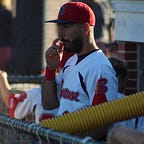How We Have Handled Defensive Positioning
Shifting is something that is pretty common place when it comes to most MLB Organizations. Most teams implement some form of shifting at almost every level of play. This summer we have even had players come in from all different college programs and speak about their own schools defensive positioning to varying extents.
One of the goals for our team this summer has been to limit the Batting Average of Groundballs that are hit into play. To do this we needed to implement some form of defensive positioning system that would help to put players in the right spot when groundballs are hit. Of course players need to be able to make the play once they are in the correct spot. But the goal was to be the best positioned team throughout the season.
As we set out on this goal it was of the utmost importance to make sure that we blended what we were seeing on the field with what we were seeing on the backside of things. The Cape Cod League offers many different avenues to help facilitate this process. From Pointstreak Charts, to TrackMan information, and lastly a corporate partnership with Synergy Baseball which allowed us to gather information on College Hitting Tendencies. We wanted to think deeply about how we were going to weigh these multiple different inputs as a staff so that we can blend everything while also performing some mental calculus.
Pointstreak offers us an unique view from the Cape League. They are able to show the batted ball profile for hitters while they were on the Cape. This is really important because the competition and velocity can be different from what players see at school in many ways so taking this into effect was one thing that the staff stressed as we set out to develop our systems and processes. Pointstreak isn’t perfect but it does give us an idea as to where players are putting the ball into play when it came to a higher level of competition.
Second thing that we were able to implement through TrackMan were what I call “Pie Slice Charts” which essentially show on a very small sample where players hit groundballs in their time on the Cape. Giving us another look into what might be under the hood of a players tendencies.
Lastly from the backside we were able to log into Synergy and start to look at where players hit groundballs in school. This was probably the hardest to weigh as the competition level for some players may not have been what we had in the Cape. So think of a player who may be geared up for fastballs while at school only to be overmatched at the Cape as the velocity ticks up a few notches on a consistent basis.
So from the backside we wanted to make sure that we had a way to communicate this effectively to everyone on the coaches staff. Simplifying our verbiage so that it was easily understood by staff, coaches, and players was a definite consideration that was taken.
When developing our language around the system we settled on:
Straight- Normal Defensive Alignment
Slight- What most teams would call a strategic shift. In this situation SS and 2B both played on the ‘normal’ side of the bag but with the fielder almost over the second base bag.
Shift- What you would think when you picture the defensive positioning for infields in the ‘shift’.
With this understanding we then set out a few defaults for all players. All batters regardless of handedness were automatically set to the ‘slight’ position for their handedness regardless of their spray charts. The burden for the hitter was to move us off of this slight positioning and move us into either the ‘shift’ or ‘straight’ positioning. For LHH the proof for a ‘shift’ alignment was lower than that of a RHH. The thought process was to mimic what Tom Tango wrote about a few months ago.
The last piece of the puzzle was blending on what the staff saw on a daily basis from hitters. Where they ‘spinners’, or ‘punchers’ so that we could be more balanced in our approach rather than just going forward without properly weighing what was happening in front of us.
Once we had the system in place, I wanted to make it so that we had a target metric that we could use as our Key Performance Indicator. I had settled on Batting Average On Balls on Balls In Play (BABIP). This was where my mind went first. The idea being that if a ball is hit into play we would be in the correct position to make the out.
As a result of all this we can see that ultimately we were successful with implementing a system that put players in the correct spots to make plays. At several point of the season we have taken away over 75 points in batting average against the average team when groundballs are hit. Here is a snapshot from earlier in the summer.
Obviously with a limited sample size of games there can be random fluctuations but I think this points to this process working out for us as a team. It has allowed us to take away hits that would have otherwise been singles or bleeders even with out large swings in positioning. I would estimate that we went into the heavy shift format for roughly one batter a game with the majority of batters playing in the slight positioning.
As we worked through this process my goal was to incorporate everyone into the process and offer what we felt was the optimal position to play hitters. Though I don’t think this system was complete I do consider it to be the very baseline that others could add to in the future to effective save runs and hopefully to ultimately win more games.
